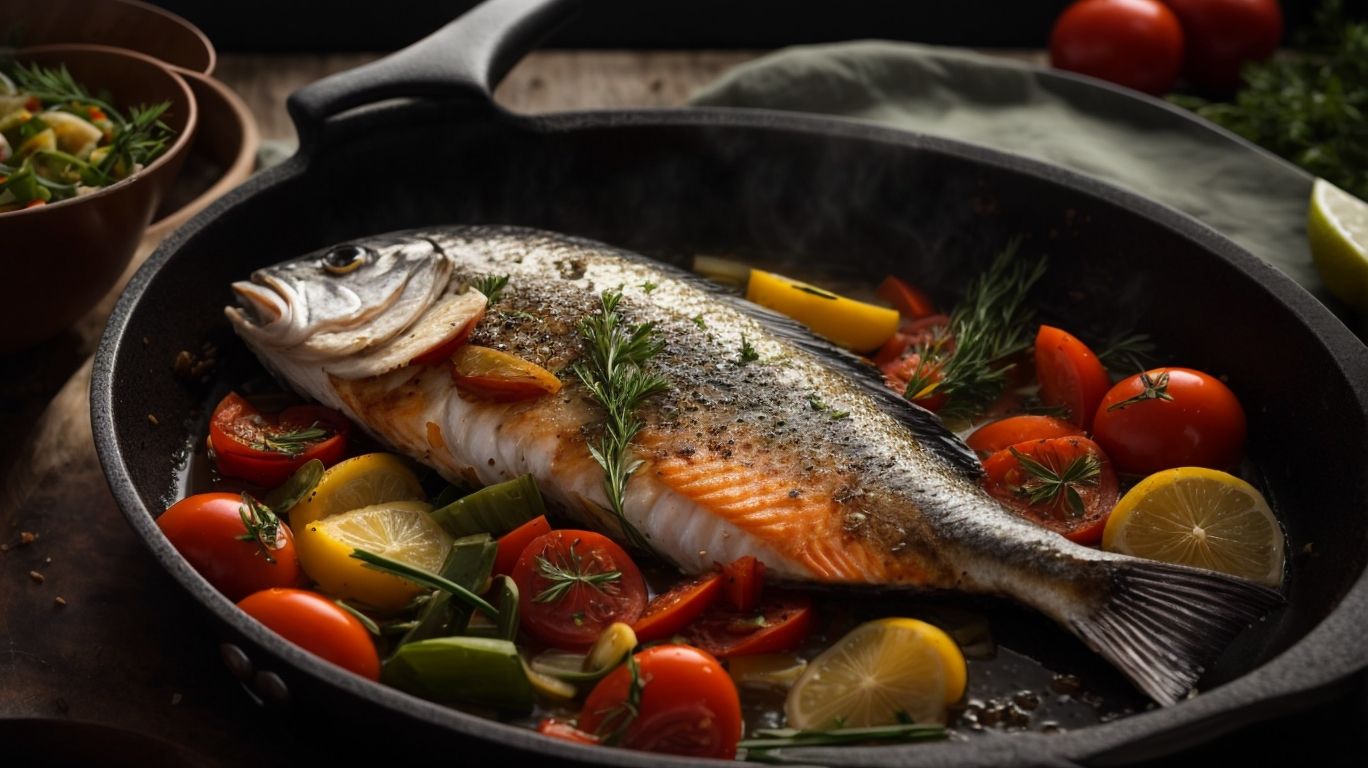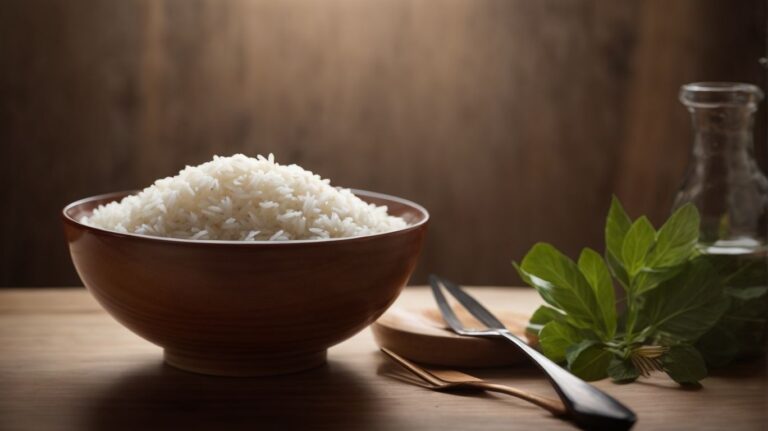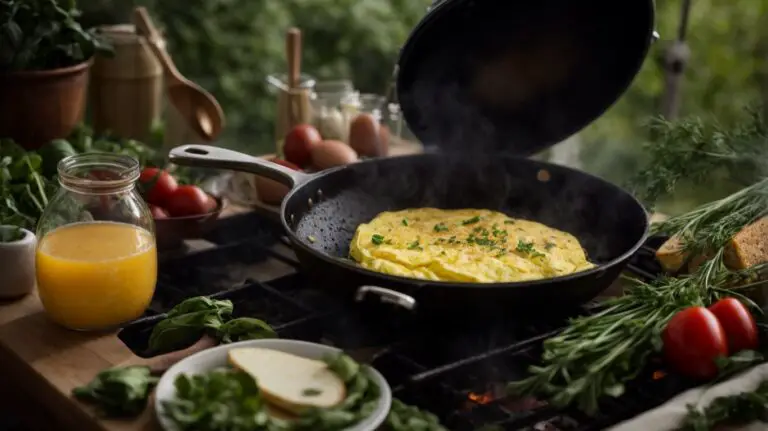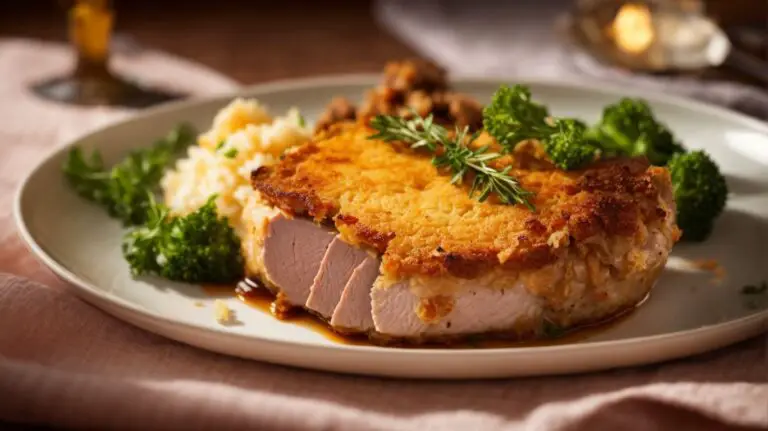How to Cook Fish on a Pan?
Looking to elevate your cooking skills and impress your friends and family with a delicious meal?
Try pan-cooking fish! We explore the best types of fish for pan cooking, the essential equipment you need, step-by-step instructions for cooking fish on a pan, tips for perfectly cooked fish, and variations to spice up your dish.
Whether you’re a novice in the kitchen or a seasoned chef, let this article guide you to culinary success.
Key Takeaways:
What Types of Fish are Best for Pan Cooking?
In terms of pan cooking fish, selecting the right type of fish is crucial for a delicious meal.
White fish, such as cod or halibut, are mild and versatile, making them perfect for pan cooking as they readily absorb flavors. Salmon offers a rich, buttery taste with a flaky texture that pairs well with various seasonings and sauces. On the other hand, tuna is a firm fish that is great for pan-searing, providing a meaty texture and bold flavor. Trout is delicate and flavorful, ideal for quick cooking methods like pan-frying to preserve its tenderness.
White Fish
White fish, known for its mild flavor and delicate texture, is a popular choice for pan cooking due to its versatility in absorbing seasonings and flavors.
One of the standout qualities of white fish is its ability to easily take on various seasonings, making it ideal for those who enjoy experimenting with flavors in the kitchen. The mild taste of white fish also makes it a great canvas for bold marinades, herbs, and spices.
Popular white fish recipes for pan cooking include pan-seared white fish with a lemon butter sauce, crispy breaded white fish fillets, and garlic-parmesan crusted white fish. In terms of seasoning, options range from classic choices like salt, pepper, and dill to more exotic blends like Cajun seasoning or Asian-inspired marinades.
When cooking white fish in a pan, it’s important to ensure that the heat is not too high as white fish can easily overcook and become dry. To achieve a perfectly cooked white fish fillet, aim for a tender, flaky texture by cooking it gently on medium heat and flipping it only once during the cooking process.
Remember to season the fish generously on both sides before placing it in the pan to enhance its natural flavors. Using a non-stick pan or a well-seasoned cast-iron skillet can help prevent the fish from sticking and ensure a beautifully seared exterior.
Whether you prefer a simple lemon and herb seasoning or a more complex blend of spices, white fish offers endless opportunities for culinary creativity in pan cooking.
Salmon
Salmon, with its rich, buttery texture and robust flavor, is a favorite choice for pan cooking, offering a succulent and nutritious meal option.
When pan-cooking salmon, it’s essential to enhance its natural flavors with the right seasonings. A simple mix of salt, pepper, and a hint of lemon zest can bring out the delicate taste of the fish. For extra depth, try sprinkling some fresh herbs like dill or parsley over the fillets before cooking. Marinating the salmon in a mixture of soy sauce, garlic, and honey can infuse it with a sweet-savory profile.
Meal planning with salmon opens up a world of possibilities. Whether grilled, baked, or seared, this versatile fish can be paired with various sides such as roasted vegetables, quinoa salad, or cauliflower mash for a wholesome and balanced meal. Consider adding a drizzle of balsamic glaze or a dollop of avocado salsa to elevate the flavors further.
Tuna
Tuna, a versatile and meaty fish, is perfect for pan cooking, offering a quick and flavorful meal option for seafood lovers.
When selecting tuna for pan cooking, opt for fresh cuts with vibrant red flesh, indicating high-quality meat. Tuna steaks around 1 inch thick are ideal for quick searing in a hot pan. To enhance the natural flavors of tuna, consider seasoning it with a blend of soy sauce, garlic, and ginger for an Asian-inspired touch. Alternatively, a mix of lemon zest, thyme, and black pepper can provide a zesty Mediterranean flavor profile.
For the best results, preheat the pan until it’s smoking hot before adding the tuna steaks. Sear each side for about 1-2 minutes to achieve a crispy exterior while keeping the inside tender and juicy. Be cautious not to overcook the tuna, as it can become dry and lose its succulence. Once cooked, let the tuna rest for a few minutes before slicing it thinly and serving with fresh herbs or a drizzle of olive oil.
Trout
Trout, with its delicate texture and mild flavor, is an excellent choice for pan cooking, offering a light and flavorful dish for any occasion.
Trout’s versatility in absorbing flavors makes it a perfect canvas for various herbs and seasonings. Herbs like dill, thyme, or parsley complement its taste beautifully. In terms of seasoning, a simple mix of salt, pepper, and a squeeze of lemon can enhance the natural flavors of the fish.
To cook a delicious trout dish, start by patting the fish dry and seasoning it generously with your chosen herbs and spices. Heat a skillet with a bit of oil over medium heat and place the trout fillets skin-side down. Cook for 3-4 minutes until the skin is crispy and golden. Then, flip the fillets and cook for another 2-3 minutes until the fish is cooked through and flakes easily with a fork.
What Equipment Do You Need for Pan Cooking Fish?
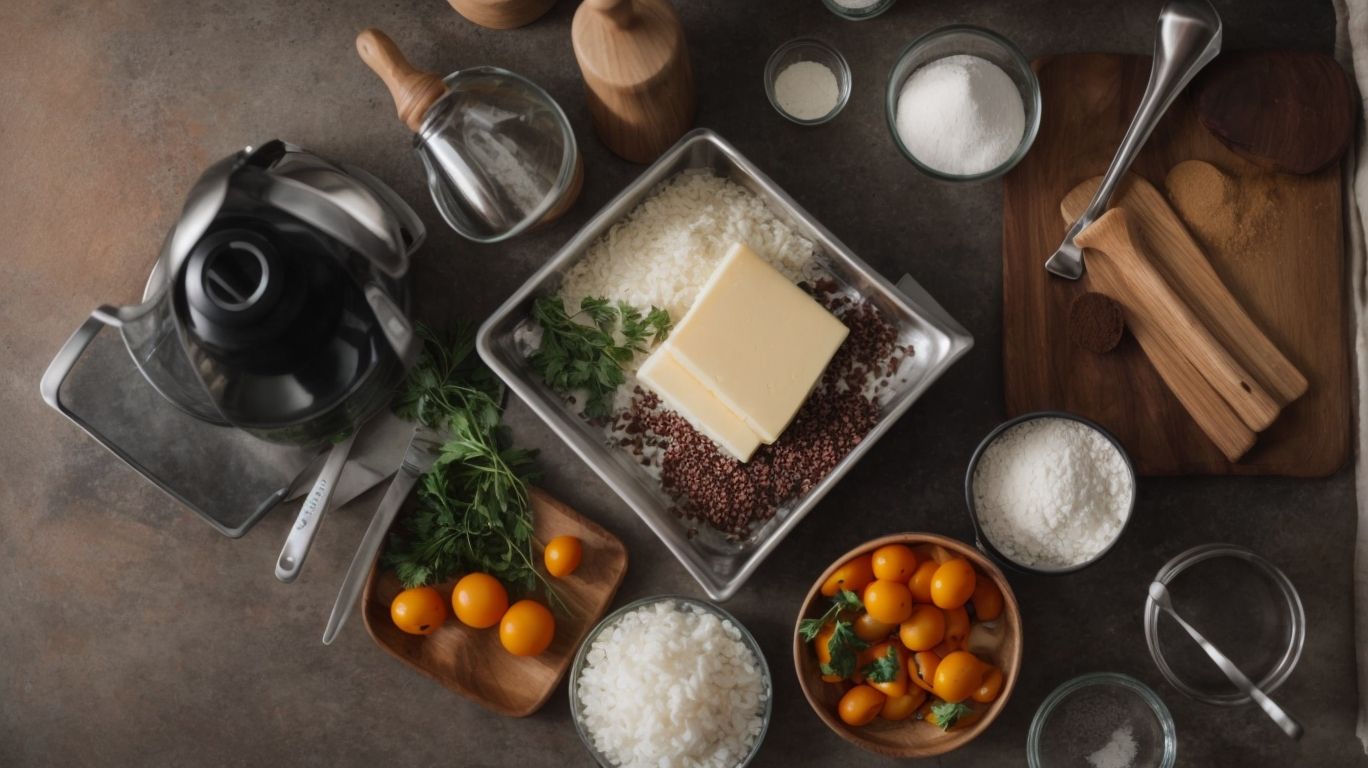
Credits: Poormet.Com – Jason Smith
To pan cook fish successfully, having the right equipment is essential to ensure a seamless cooking process.
One key piece of equipment crucial for pan-cooking fish is a non-stick pan. The non-stick surface ensures that the delicate fish fillets do not stick, making flipping them easier and preventing them from falling apart. It also helps in achieving a beautifully seared exterior without the fish sticking to the pan.
Using a spatula and tongs is vital. A spatula helps in gently flipping the fish without breaking it, while tongs are useful for turning larger fillets or whole fish. These tools assist in maintaining the fish’s integrity during the cooking process.
Incorporating a bit of oil or butter in the pan adds flavor and prevents the fish from drying out. The choice between oil or butter depends on personal preference and the desired flavor profile of the dish.
Non-stick Pan
A non-stick pan is a versatile and essential tool for pan cooking fish, ensuring that the fillets cook evenly and prevent sticking during the cooking process.
One of the major benefits of using a non-stick pan when cooking fish is that it requires less oil or fat, making it a healthier cooking option. The non-stick surface allows you to achieve a crispy exterior on the fish without overcooking or burning it. Cleaning up after cooking with a non-stick pan is a breeze as food residue easily slides off the surface. To maintain the non-stick coating, it is important to avoid using metal utensils and abrasive cleaners that can scratch the surface. It’s also recommended to hand wash the pan instead of using a dishwasher to prolong its lifespan.
Spatula
A reliable spatula is essential for flipping and serving fish cooked in a pan, ensuring that the fillets are handled gently to preserve their texture and presentation.
When working with delicate fish like flounder or tilapia, the right spatula can make all the difference in preventing them from falling apart during the cooking process. By using a spatula with a thin edge, you can easily slide it under the fish without disturbing its shape.
Once the fish is perfectly cooked, seasoning it with just the right amount of salt and pepper can elevate the flavors to a whole new level. Simple yet effective, these two common ingredients can enhance the natural taste of the fish without overpowering it.
Tongs
Tongs are essential for handling and turning fish fillets in a hot pan, ensuring even cooking and precise control over the cooking process.
When using tongs to cook fish fillets, it is crucial to gently place the fillets in the pan to prevent splattering of hot oil and maintain the fillets’ shape and integrity. By carefully flipping the fillets with the tongs, you can prevent them from breaking apart, resulting in beautifully cooked fish with a delicate texture.
The heat level plays a vital role in achieving the perfect fish dish. Medium-high heat is generally recommended for a crispy exterior while keeping the fish tender inside. Seasoning with salt, pepper, and a sprinkle of lemon juice can enhance the natural flavors of the fish.
Timing is key in pan-cooking fish. Overcooking can lead to dry and tough fillets, while undercooking may result in raw portions. Monitoring the cooking time closely and serving the fillets immediately after cooking will ensure a delicious and satisfying dish for your meal.
Oil or Butter
Oil or butter are essential ingredients for pan-cooking fish, adding flavor, enhancing texture, and preventing sticking during the cooking process.
When deciding between oil and butter for pan-cooking fish, it’s vital to consider their distinct roles.
- Oil is ideal for high-temperature cooking due to its higher smoke point, making it suitable for searing fish and achieving a crispy exterior.
- On the other hand, butter imparts a rich, indulgent flavor to the fish but has a lower smoke point, so it’s better suited for medium to low heat cooking.
To enhance the flavor profile, consider incorporating seasonings like lemon zest, fresh herbs, garlic, or a sprinkle of smoked paprika for that extra depth of taste.
Steps for Cooking Fish on a Pan
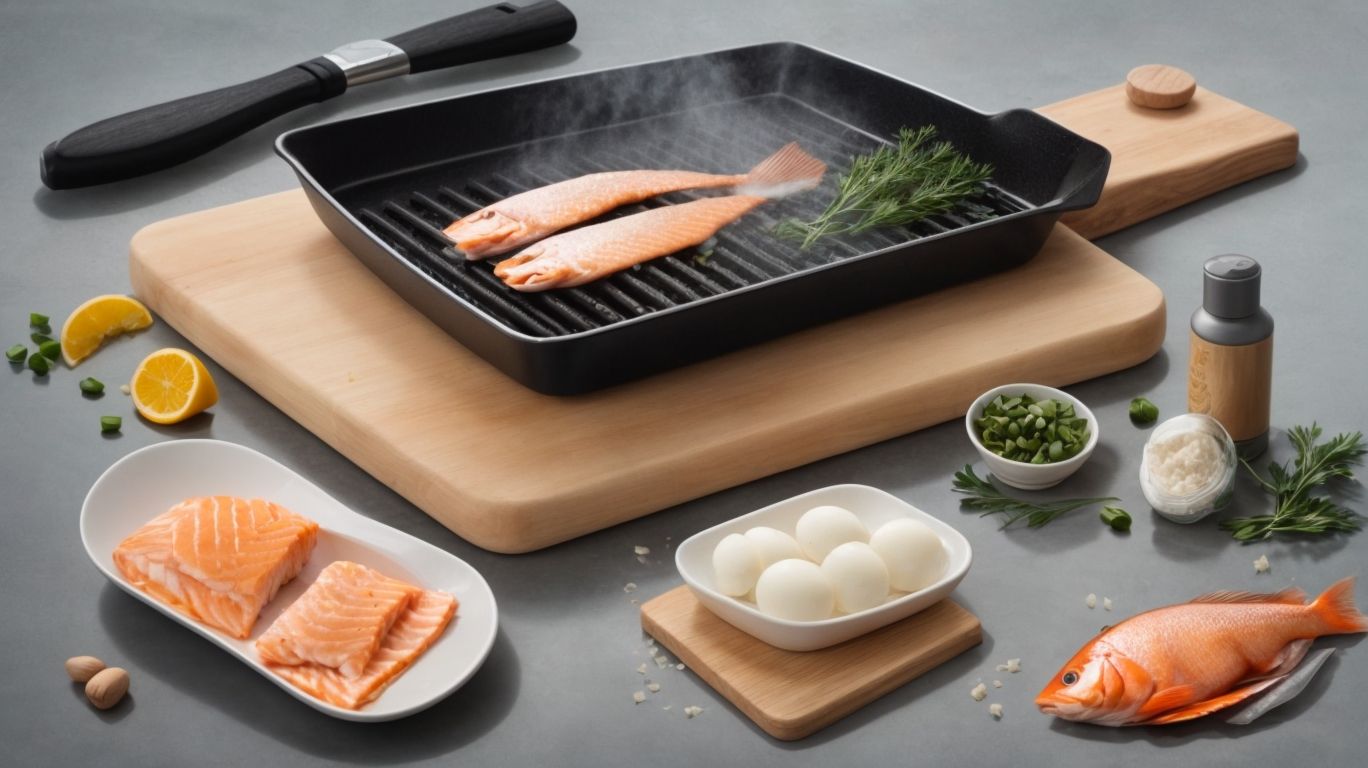
Credits: Poormet.Com – Anthony Rivera
Cooking fish on a pan can be a delightful culinary experience that involves a few simple steps to achieve perfectly cooked fillets bursting with flavor.
Ensure that you have a fresh piece of fish, such as salmon or cod, preferably deboned and skin-on for added flavor. Next, select a good-quality non-stick pan and heat it up with a touch of olive oil over medium-high heat. While the pan is heating, season the fish fillets with a sprinkle of salt, pepper, and a squeeze of fresh lemon juice. Once the pan is hot enough, carefully place the seasoned fish fillets skin-side down to achieve a nice crispy texture.
Cook the fish for a few minutes on each side, depending on the thickness of the fillets, until they are cooked through and flake easily with a fork. Avoid overcrowding the pan to ensure even cooking. If desired, you can add some herbs like thyme or dill to enhance the flavor profile. Remember to adjust the cooking time based on the type of fish and your preferred level of doneness.
Once the fish is cooked to perfection, remove it from the pan and let it rest for a couple of minutes before serving. Garnish with fresh herbs or a drizzle of extra-virgin olive oil for a final touch of flavor. Pair your delicious pan-seared fish with a side of salad or roasted vegetables for a wholesome and satisfying meal.
Preparing the Fish
Properly preparing the fish before pan cooking is essential to ensure that the fillets are seasoned, fresh, and ready for a flavorful cooking process.
One crucial step in prepping fish for pan cooking is to thoroughly clean and pat dry the fillets to remove any excess moisture, as this helps in achieving a crispy and well-seared exterior. Seasoning the fish with a blend of herbs and spices not only enhances its natural flavors but also adds depth to the overall dish.
For those looking to elevate the taste profile of the fish, incorporating ingredients like herb butter, fresh lemon zest, or a splash of white wine can introduce a delightful complexity that pairs beautifully with the tender flesh of the cooked fish.
Preparing the Pan
Preparing the pan correctly before cooking fish is crucial to ensure that the fillets cook evenly and develop a flavorful crust during the cooking process.
One essential step is to preheat the pan properly before adding the fish. This helps in creating a sear on the outside of the fillet while maintaining the delicate texture inside. A well-preheated pan also prevents the fish from sticking to the surface. For seasoning, a classic combination like black pepper and garlic powder works wonders, adding depth of flavor without overpowering the natural taste of the fish. In terms of choosing the right oil, opt for high smoke-point oils such as canola or vegetable oil to prevent burning and maintain the integrity of the dish.
Cooking the Fish
Cooking the fish to perfection on the pan involves precise timing, heat control, and proper seasoning to ensure that every fillet is cooked through and bursting with flavor.
In terms of pan-searing fish, it’s essential to start with a hot pan to achieve that coveted crispy exterior while ensuring the flesh remains moist and tender within. Begin by patting the fish fillets dry with a paper towel to remove any excess moisture, as this helps create a beautiful sear. Gently lay the fillets seasoned side down in the hot pan to prevent sticking and promote even browning.
For optimal results, refrain from overcrowding the pan to allow the fillets enough space to cook properly. Adjust the heat as needed to maintain a consistent sizzle without burning the exterior of the fish. A good rule of thumb is to cook fish for about 3-4 minutes per side, depending on the thickness of the fillet. Always use a spatula to carefully flip the fillets to prevent any breakage.
Tips for Perfectly Cooked Fish
Achieving perfectly cooked fish on a pan requires attention to detail and following key tips to ensure that each fillet is flavorful, moist, and cooked to perfection.
One essential tip for cooking fish on a pan is to avoid overcooking by closely monitoring the cooking time. High heat can help achieve a crispy exterior while keeping the center tender and juicy. Seasoning plays a vital role in enhancing the natural flavors of the fish; a simple mix of salt, pepper, and fresh herbs can go a long way. After cooking, allow the fish to rest for a few minutes before serving to allow the juices to redistribute, resulting in a more flavorful dish.
Don’t Overcook the Fish
One crucial tip for perfectly cooked fish is to avoid overcooking, as it can lead to dry and less flavorful fillets that may not be as enjoyable.
When cooking fish, it’s important to recognize visual cues that indicate it’s properly cooked. For example, fish that is opaque and easily flakes with a fork is usually done. The flesh should be moist and slightly translucent. If you’re unsure, you can use a food thermometer to ensure it reaches an internal temperature of 145°F.
To prevent overcooking, consider using gentle cooking methods like steaming, poaching, or grilling. These methods allow you to control the cooking process more effectively and reduce the risk of drying out the fish. Another tip is to remove the fish from heat just before it’s fully cooked as residual heat will continue to cook it slightly.
Use High Heat
Utilizing high heat when cooking fish on a pan allows for quick searing, flavorful browning, and preserving the fish’s moisture for a delightful dining experience.
When you apply high heat to the fish, it creates that beautiful golden crust on the outside while keeping the interior tender and juicy. This method not only enhances the visual appeal of the dish but also locks in the natural flavors, resulting in a more intense taste profile. High heat also helps to cook the fish quickly, reducing the risk of overcooking and ensuring a perfect texture. Managing the heat properly is crucial; ensuring that the pan is preheated and maintaining the right temperature throughout the cooking process is key.
Season the Fish
Seasoning the fish generously before cooking is key to enhancing its flavor profile, ensuring that each bite is seasoned to perfection and delights the taste buds.
In terms of seasoning fish, a simple yet effective combination of salt and pepper can work wonders. The salt enhances the natural flavors of the fish while the pepper adds a subtle kick of heat. For those looking to elevate the flavor even further, consider experimenting with herbs like dill, parsley, or thyme. These herbs not only add freshness but also bring a depth of flavor that complements the fish beautifully.
Let the Fish Rest Before Serving
Allowing the cooked fish to rest briefly before serving is essential to lock in the flavors, juices, and tenderness for a delightful dining experience.
When fish is cooked, the heat redistributes the juices inside the meat. Allowing a brief resting period helps the juices to settle back evenly, ensuring every bite is succulent and full of flavor. This process, known as ‘carryover cooking,’ also continues to gently cook the fish, contributing to its overall doneness without overcooking. As the fish rests, the flavors intensify, enhancing the taste profile and making the dish more enjoyable for the palate.
Variations for Pan Cooking Fish
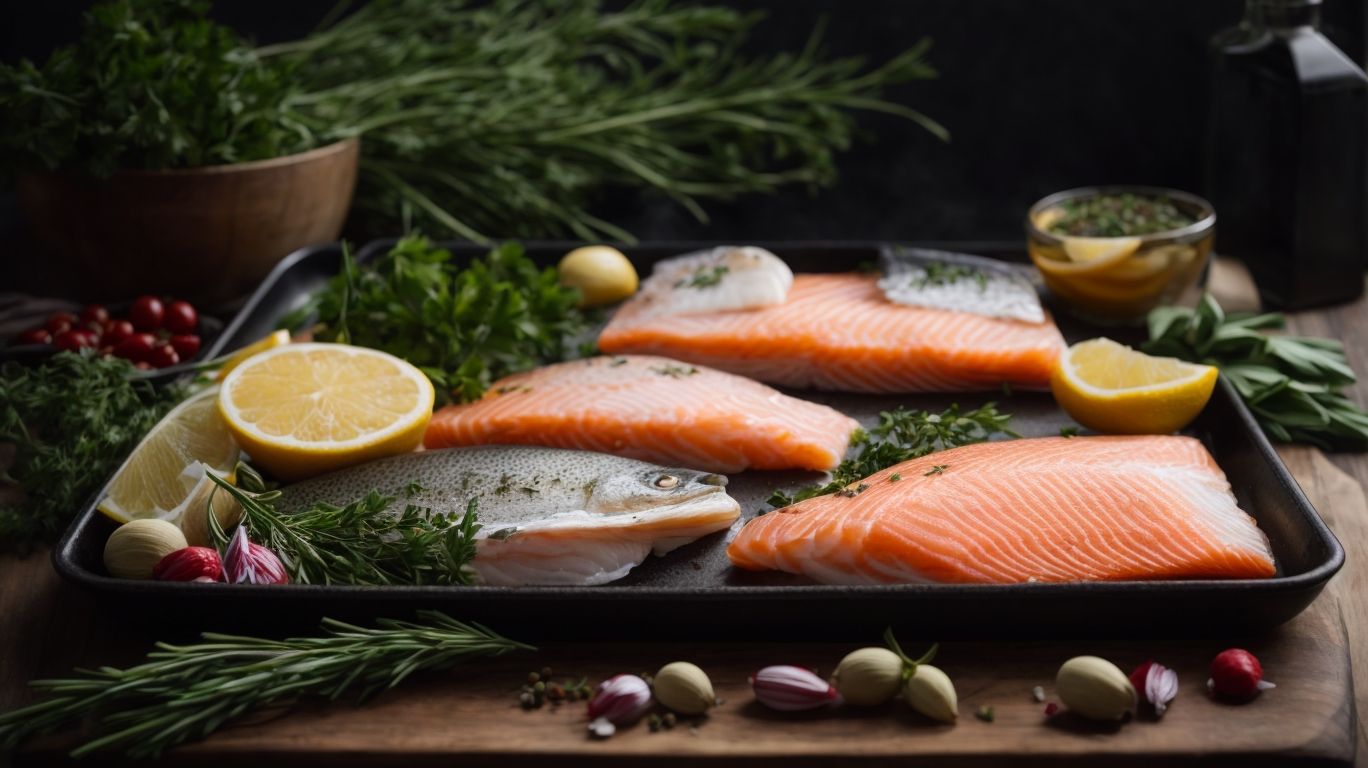
Credits: Poormet.Com – Roy Clark
Exploring different variations for pan cooking fish can elevate your culinary repertoire and introduce new flavors and textures to your meals.
One delicious pan-cooking method is pan-frying fish, where you lightly coat the fish in flour or breadcrumbs and cook it in a sizzling hot pan until crispy on the outside and tender inside. For a bolder flavor, blackened fish involves coating the fish in a mix of spices like paprika, cayenne, and garlic before searing it in a smoking hot pan.
If you prefer a crunchy texture, try breaded fish, where the fish is coated in breadcrumbs or cornmeal and then pan-fried until golden and crispy. Each method offers a unique culinary experience with distinct seasoning profiles that can cater to a variety of taste preferences.
Pan-Fried Fish
Pan-fried fish offers a classic and versatile cooking method that results in crispy exteriors and tender interiors, perfect for a delicious meal plan.
When preparing pan-fried fish, start by selecting a fresh fillet like tilapia, cod, or salmon, ensuring it is patted dry to promote a crispy texture. Seasoning options can vary from simple salt and pepper to more elaborate herb and spice blends, depending on your taste preferences.
To achieve a perfectly cooked dish, ensure your skillet is adequately preheated with a thin layer of oil, allowing the fish to sizzle upon contact for that desired crunch. Remember not to overcrowd the pan to maintain the ideal temperature and prevent steaming.
For added flavor, consider incorporating ingredients like garlic, lemon, or capers during the cooking process, elevating the taste profile of the dish. Taking care not to overcook the fish is crucial; watch for a golden-brown crust before gently flipping to cook the other side.
Blackened Fish
Blackened fish, known for its bold and spicy flavor profile, is a popular variation for pan cooking that adds a unique and zesty twist to seafood dishes.
When blackening fish, the key is to coat the fillets with a mixture of flavorful spices before searing them in a hot skillet. A classic blackening spice blend often includes paprika, cayenne pepper, garlic powder, onion powder, thyme, and oregano. For those looking to enhance the heat level, adding extra cayenne or chili powder can ramp up the spiciness. To balance out the kick, a touch of sweetness from brown sugar or a tangy note from lemon zest can be incorporated.
Breaded Fish
Breaded fish offers a crunchy and satisfying texture that complements the tender fish fillets, making it a delightful choice for pan cooking with a comforting twist.
To achieve a perfectly crispy and golden crust, start by preparing a batter using a combination of flour, eggs, and seasonings like salt, pepper, and garlic powder. Dredge the fish fillets in the batter, ensuring an even coating.
Next, coat the fish fillets in breadcrumbs; you can use traditional breadcrumbs or experiment with panko for extra crunch. For added flavor, consider incorporating grated Parmesan cheese or chopped herbs into the breadcrumb mixture for a gourmet touch.
Conclusion
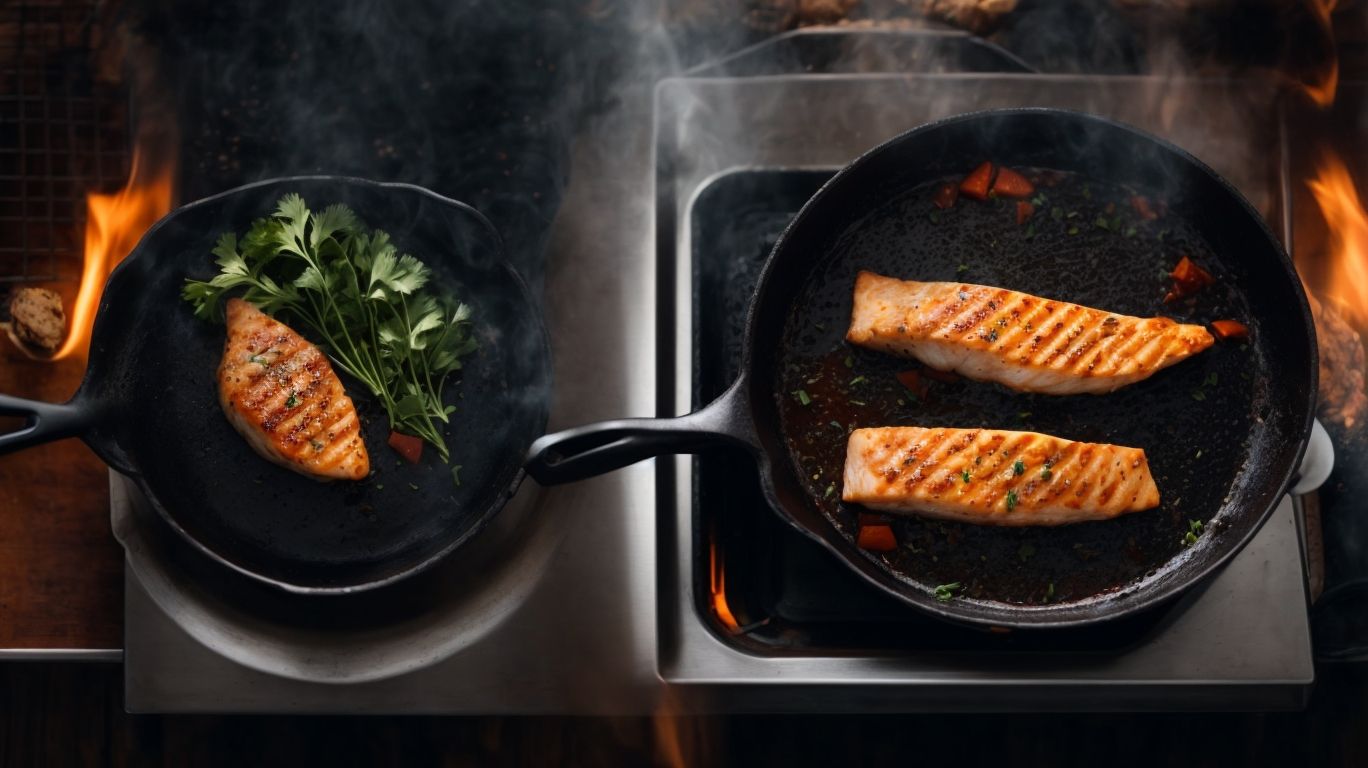
Credits: Poormet.Com – Richard Davis
Pan cooking fish offers a versatile and delicious way to prepare seafood dishes, allowing for a myriad of flavors and textures to tantalize your taste buds.
One of the advantages of pan-cooking fish is the quick cooking time it provides, making it a convenient option for weeknight meals or last-minute dinner plans. The use of different seasonings, sauces, and accompaniments can transform a simple fish fillet into an extraordinary culinary delight.
Experimenting with various cooking techniques, such as searing, sautéing, or even blackening, can bring out different dimensions of flavor in the fish, keeping your meals exciting and diverse. Remember to pay close attention to the cooking time and temperature to ensure that the fish is cooked to perfection, tender and flaky.
Frequently Asked Questions
1. How to Cook Fish on a Pan?
Cooking fish on a pan is a simple and delicious way to prepare this nutritious protein. Follow these steps for the perfect pan-cooked fish.
Step 1: Choose your fish. Opt for firm and thick fillets like salmon, cod, or halibut. These hold up well on a pan and are less likely to fall apart.
Step 2: Season your fish. Use a dry rub or marinade to flavor the fish before cooking. This adds depth to the dish and prevents it from being bland.
Step 3: Heat your pan. Use a non-stick pan and heat it over medium-high heat for a few minutes. This will ensure that your fish cooks evenly and doesn’t stick to the pan.
Step 4: Cook the fish. Place the fillet skin-side down on the hot pan and cook for 3-4 minutes. Flip the fish and cook for an additional 3-4 minutes, or until it flakes easily with a fork.
Step 5: Serve and enjoy. Plate your cooked fish and serve with your favorite side dish or on top of a salad for a healthy meal.
2. What type of pan should I use to cook fish?
For pan-cooked fish, it’s best to use a non-stick pan to prevent the fish from sticking to the bottom. This will also make it easier to flip the fish without breaking it apart.
3. Can I cook frozen fish on a pan?
Yes, you can cook frozen fish on a pan. However, it’s best to thaw the fish before cooking to ensure even cooking and prevent any potential bacterial growth. If you must cook frozen fish, make sure to thaw it completely before adding it to the pan.
4. How do I know when the fish is cooked?
The best way to know when the fish is cooked is to use a thermometer. Fish should be cooked to an internal temperature of 145 degrees Fahrenheit. You can also use a fork to gently flake the fish – if it flakes easily, it’s done!
5. What types of seasoning should I use for pan-cooked fish?
The seasoning you use will depend on personal preference and the type of fish you are cooking. Some popular options include lemon pepper, Cajun seasoning, garlic and herb, or a simple salt and pepper mix. Experiment with different flavors to find your favorite.
6. Can I cook fish on a pan without oil?
Yes, you can cook fish on a pan without oil. However, using a little bit of oil or cooking spray will help prevent the fish from sticking to the pan and add a nice crispiness to the outside of the fish. If you prefer to cook without oil, make sure to use a non-stick pan and monitor the fish closely to prevent it from burning.

